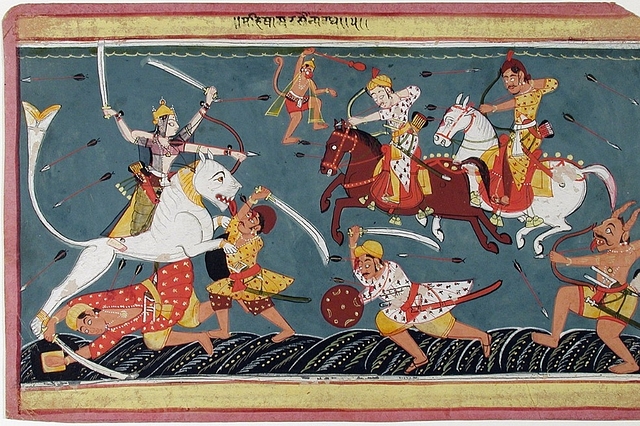
Random Meditations Through Her 1000 Names - VII
The so called idol worship, which is the worship of the physical form of the deity, is arguably the greatest innovation in the history of religion and spirituality.
Read part six here.
Chaturbahusamanvita – She who has four hands. This is the seventh name of the Goddess. This name is the preamble for what the Goddess does in the inner battle.
The Goddess has three forms. They are not contradictory but complementary. These are the gross form (sthula), the subtle form (sutshuma) and the supreme form. The last form is called vasanamaya. Corresponding to this humans also have three forms. The first two forms, physical and psychological are made of the physical elements. The third form for the humans is made of the results of their karmic deeds. Thus, the human forms obey the laws of physical sciences and karma. However, the forms of the deity are ‘aprakritha sarera’ or forms that are not bound by the laws of nature. The gross form of the Goddess can be understood as the gateway to understand Her real form.
The gross form can be comprehended by the physical senses of the humans. The subtle form has mantra dimensions to it. It can be comprehended by the mind. The supreme form can be comprehended only by transcending the body and mind, through the self and by Her grace. For the seeker, she or he uses both the physical and subtle forms of the Goddess to realise the third form.
Saiva Siddhanta relates the ability to receive the Divine through these three forms to the three inner impurities as they are spread among the populations. When a human being has all the three inner impurities – ego, karma and maya they are called Sakalar. For them, the grace comes through the gross form of the Deity. Human beings with ego and karma are pralayakalar. For them the divine grace comes through the subtle form of the Deity. Those with only one inner impurity, the ego or ahankar, for them the grace comes through the Supreme light form.
One should realise then that no form of the deity in itself can be considered as superior or inferior for the devotee. When the devotee forms the relation and loves the Deity, that form is indeed superior to the individual as it forms the gateway without which one cannot progress in the science of self-realisation. So, though She is the most incomprehensible and all pervading, transcending everything and nothing, She is also this form that you view in the village temple. There is, in reality, no difference.
The so-called idol worship of the Hindus is one of the most wonderful discoveries humanity ever made in the field of the science of religions. Those religions which forbid the physical forms actually gave their gods psychological forms. The physical forms that the Hindu seers arrived for our Deities through meditation, suit the human inner diversity. And as the seeker progresses, these forms naturally give way to the infinite dimensions of reality to which they themselves open up. But imprisoning the minds to the physically-formless-but-psychological forms of ego gods (as Ram Swarup called them) makes those minds and the social milieu that cultivates the worship of such ego gods, tough for inner flowering. The result is that the declaration of ‘Anal Haq’ gets a Mansur `Al-Hallaj killed, whereas 'Aham Brahamsmi' has always been welcome in India.
‘Anna’ Subramaniam points out that the Goddess is also seen as having five forms – sthula, sushtuma, sushmatara (kamakala-form), sushmatama (kundalini form) and sutha-Brahama forms.
So the name Chaturbahusamanvita describes is the sthula form of the Goddess. The four hands are said to be the four chiefs of the armies of the Goddess. The hands of the Goddess are described first and the weapons She holds in these hands are described in the next. The four chiefs of the army of the Goddess are Asvarudha (Goddess of the horses), Sampatkari (Goddess of the elephant hordes), Mantrini (Goddess who rides the chariot Geyachakra) and Varahi (the boar goddess). The role of each of them in the battle with Bandasura and the inner meaning of their roles are described in the names 66, 67, 69, 70,75 and 76. In the names four to seven, from Chidagnikundasambutha to Chaturbahusamanvita, Her very generalized form is described. The names 12 to 55 describe the detailed and complete form of the Goddess from head to the feet. From these we can understand that the description of the form with four hands and then the weapons in these hands can be seen as the preamble for both the form and action of the Goddess.